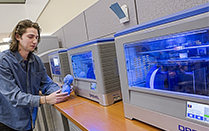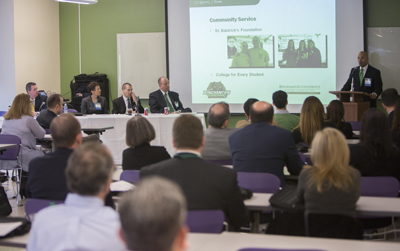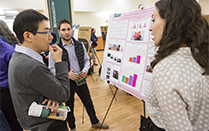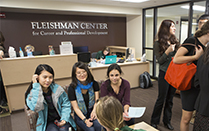Binghamton University President Harvey Stenger's Road Map Quarterly Report - June 30, 2016
Another academic year is in the books. The spring 2016 semester was eventful — with an extraordinary graduating class, progress on both our Road Map and our new health sciences campus in Johnson City, and a first glimpse of next year’s entering students. We even had a visit from former President Bill Clinton.
If I could summarize the end of the academic year in one word, I think it would have to be “exciting.” Of course, this is always most evident in the joy and enthusiasm that our graduates and their families take ending this chapter in their lives and moving on to the next. My window in the Couper Administration building overlooks the Peace Quad where we’ve moved the “berm” that used to stand in the Bartle Drive traffic circle. The berm, with its emblematic “Binghamton 2016” floral arrangement, has become a traditional stopping place for students wanting to capture a photograph documenting their success. Every day throughout May, graduates in caps and gowns posed with peers, friends, families and faculty – their happiness palpable even from eight floors above.
But end-of-the-year excitement involves more than just those who are graduating — other students prepare for summer courses, internships and study-abroad programs, faculty enjoy having time to concentrate on their research and scholarship, and staff shift their focus from the immediacy of student-centered work to longer-term projects and initiatives. And almost everyone takes a few days of well-deserved downtime to rejuvenate in preparation for the fall semester, which is just around the corner.
Commencement, admissions and alumni
The weekend of May 20-22 saw the campus host eight Commencement ceremonies, with more than 3,500 graduates receiving their degrees, including 81 PhD and 609 master’s candidates. The University was pleased to welcome back to campus U.S. Sen. Charles Schumer who spoke to graduates at the Watson School ceremony on Saturday and the final Harpur College ceremony on Sunday. Students and families appreciated his remarks, and it helps raise the ceremonies’ visibility to have a sitting senator (and likely future Senate Majority Leader) on hand.
The University presented an honorary degree to John Bartle, dean of the College of Public Affairs and Community Service and professor of public administration at the University of Nebraska, Omaha, and he spoke at our College of Community and Public Affairs ceremony. Wearing the academic robe owned by his grandfather, founding University President Glenn G. Bartle, he urged graduates to take what they’ve learned at Binghamton to improve their communities. The University also awarded an honorary degree to noted screenwriter, producer and director Marc Lawrence. A 1981 Binghamton alumnus, Lawrence is best known for his films Miss Congeniality (2000), Two Weeks Notice (2002) and Music and Lyrics (2007), but is noted on campus for the 2014 film The Rewrite, starring Hugh Grant and Marisa Tomei, which he called his “love letter” to Binghamton. Binghamton University is featured prominently throughout the movie, raising the University’s profile for audiences around the globe.
Binghamton’s annual Commencement draws graduates’ friends and families from across New York, and around the world. All told, more than 22,000 guests descend on campus, most of whom spend time in local hotels and restaurants. This results in more than $1.65 million being spent in local economy, with a total regional economic impact of $2.66 million in Broome and Tioga counties.
Just as we say farewell to our graduates, we also take time at the end of the academic year to recognize campus leaders who are moving on. This year, Dean Anne McCall will be leaving Binghamton to become provost and senior vice president for academic affairs at Xavier University in New Orleans. McCall was only at Harpur for three years, but had a significant impact, adding over 100 new faculty and helping raise more than $500,000 to establish Harpur Edge, which connects students with resources on and off campus and helps them define their career directions. Provost Donald Nieman has appointed Terry Deak, professor of psychology, as interim dean. Similarly, this fall we will welcome to campus Mario Ortiz as new dean of the Decker School of Nursing (DSON). Ortiz comes to Binghamton from the University of Indiana-South Bend, where he served as professor of nursing at the Vera Z. Dwyer College of Health Sciences. He has expressed some very innovative ideas about increasing the reach and impact of the DSON, including possible new health-related academic programs. I thank nursing Professor Pamela Stewart-Fahs for her service as interim dean for the past year.
As we enter summer, we are preparing to welcome the class of 2020. This has been an exceptionally busy year for our admissions staff, which received a record 32,000 applications for admission — at a time when most colleges and universities are seeing a decline in applications and enrollment. With more students wanting to attend and the number of seats remaining constant at about 2,600, the campus is poised to enhance its status as one of the most selective public universities in the nation. While it is too early to have exact numbers, we can safely estimate that the average freshman SAT score for our incoming class will be in excess of 1300. We also are working to increase the yield among top-performing students, with current students and counselors calling admitted students directly with information about our programs and student life and holding receptions at locales across New York and the metro region for admitted students. We also are increasing the visibility of our premier PwC Scholars and Binghamton Scholars Programs, resulting in increased interest among applicants and admitted students.
One of the key goals of the Road Map has been to increase the visibility and reputation of our graduate programs. In this regard, the 2016 application season has been very successful. There has been a 16 percent increase in the number of completed applications and a 20 increase in deposits. And we are already seeing high interest in our School of Pharmacy and Pharmaceutical Sciences program, even though it’s not due to enroll students until fall 2017, pending precandidate status from the Accreditation Council for Pharmacy Education.
But it’s not just the Class of 2020 that is showing exceptional interest in Binghamton. We’re already seeing as part of the record number of visitors this year members of the class of 2021 and 2022 on campus — and, if the numbers of younger brothers and sisters in tow are an indication, members of the class of 2030 as well. Our campus tours have hosted nearly 43,000 visits this year, more than double the number of visitors we saw in 2005–2006.
We also welcomed a very special visitor in April when former President of the United States Bill Clinton held an event in support of former U.S. Sen. Hillary Clinton’s campaign for the presidency. More than 1,700 people packed the East Gym for the rally.
Our future students will have a number of new academic programs to choose from, particularly at the master’s level. These programs are designed to meet a growing demand for advanced master’s-level and professional coursework, and will attract new students to campus while also encouraging undergraduates pursuing advanced studies to remain at Binghamton. Already we have instituted several new master’s-level programs, including:
• One of the nation’s first master’s program in sustainable communities
• Teaching English to Speakers of Other Languages (TESOL)
• Public archeology
• Applied statistics, which is already leading to increased applications in mathematics
We also are moving forward on:
• A master’s in Applied Liberal Studies (MAALS). SUNY has approved our Letter of Intent (LOI) with program development proceeding. Received Faculty Senate approval in May 2016.
• Public health LOI approved, full program development in early phases.
• Data analytics LOI approved, full program development in early phases.
• The University is also adding two new certificate programs: social work in healthcare settings and social work in community schools
Our students value these programs because they see the way that advanced courses add to their career opportunities. All of this is good news for our newest alumni, who will be entering the workforce at a time when economists see the best job market for college graduates in over a decade. In fact, the combination of academic excellence and value at Binghamton is widely recognized, with the campus consistently receiving recognition for its return on investment (ROI). ROI has become a popular way of gauging a university’s impact, and by this measure Binghamton does quite well. For example, bizjpournals.com ranks Binghamton graduates 9th among upstate public and private colleges for average annual earnings after 10 years on the job — making Binghamton the only SUNY campus in the top 10. And it’s not just the high-wage alumni in our School of Management and engineering programs who are doing well — in a recent survey of humanities graduates by Payscale.com, Binghamton University graduates ranked first in the nation in terms of their ROI and post-graduation salaries.
This was the message shared by a number of successful alumni from our Theatre Department who returned to campus in April to participate in panel discussions, workshops and networking events for students in the program. Their main message was about the variety of career options open to students in the theatre program. Organized by OBIE award-winning actor and writer, alumnus Ruben Santiago-Hudson ’78, the panel discussions also included Mary Consaro, Jeremy Davidson (Jeremy Greenberg), Jesse Rabinowitz, Victor Williams and Andy Wollowitz. These successful actors, directors and academics shared advice regarding working in the industry and praised the way their time at Binghamton prepared them for a life in the arts.
Even as our graduates move forward in their careers, we encourage them to remain connected to the campus. In April, more than 230 of our most successful and engaged alumni returned to share their experiences with current students and learn how to be more active in support of the campus as part of the fourth annual Alumni Leadership Conference. The conference focused on increasing alumni engagement by inspiring alumni to be more active as volunteers. The goal of the conference was to update alumni with the latest news, build alumni involvement in activities such as student mentoring and membership in regional alumni chapters, and build off the success generated by the Alumni Association’s strategic plan that was introduced last year.
The weekend also included the presentation of our alumni awards to some of the University’s most outstanding alumni — people who have distinguished themselves in their service to the campus, the community and the common good. Among those recognized were Vincent Daniel ’94, an investment guru whose ability to foresee the economic crash of 2008 is one of the highlights of the book and movie The Big Short. Also honored were academic and author Deborah Tannen ’66; Milburn Corporation CEO Barry Goodman ’79; U.S. Ambassador to the Republic of Palau Amy Hyatt ’78; and director of strategy and planning for small business products for the management consulting firm Accenture, Gregory Reynolds ’08. In addition, the Alumni Association awarded 10 Medals of Distinguished Service to individuals who have contributed to specific areas of the University’s activities as volunteers, advisors and donors.
Southern Tier Health Sciences and Technology Innovation Park and industrial partnerships
We continue to move forward on plans to establish a new campus in nearby Johnson City. The most exciting development regarding this project is the news that the University will be co-locating our Decker School of Nursing at 48 Corliss St., adjacent to the future home of our School of Pharmacy and Pharmaceutical Sciences. The property, which was purchased through a grant from the Binghamton University Foundation, is the former home of an Endicott Johnson shoebox faculty that will be completely renovated to meet the needs of our nursing school. The new home will allow for a 40 percent increase in enrollment in our nursing program as well as the hiring of additional faculty. This will strengthen the University’s presence in Johnson City and allow for better clinical and research experiences through partnerships with UHS Wilson Medical Center, Lourdes Hospital and the Broome County Health Department among others. The location will also help students receive enhanced interprofessional training, such as working with students and faculty in our social work, biomedical and systems engineering programs. We also are considering a nearby property as a site for future bio-industrial partners. Our goal is to have the Johnson City campus develop as a hub of healthcare innovation that will encourage the development of new industries and services.
The past three months have seen progress along this front as well, as the Watson School hosted the annual Northeast Bioengineering Conference, which is one of the premier conferences in a fast-changing and economically important field. The research and technologies discussed are truly at the cutting-edge of knowledge and invention and promise to fundamentally change our way of diagnosing illnesses, delivering medicines and repairing damaged tissue. This conference offered an opportunity for the University to highlight the growth of our biomedical engineering program and our efforts to establish the new health sciences campus.
The campus also hosted a symposium put together by Innovation Associates — a local company that manufactures robotic dispensers for pharmacies. Binghamton University, and especially our Watson Institute for Systems Engineering (WISE), has a number of partnerships with Innovation Associates. These include opportunities for about 30 of our graduate students who collaborate with Innovation researchers and engineers on journal articles and robotics and systems research. Significantly, this symposium brought together around 50 leading corporate pharmaceutical officers from such organizations as Welldyne, NoviXus, Costco, CVS, Walgreens, Wegmans, Walmart, and governmental and military leaders overseeing healthcare operations for the Air Force, Navy, Coast Guard and Veterans Administration. Dean Gloria Meredith addressed the group to discuss our new School of Pharmacy and Pharmaceutical Sciences (SOPPS), giving the University an opportunity to demonstrate that we are an up-and-coming player in an expanding and rapidly innovating field. In addition, I have been involved in private conversations with a number of firms that have expressed interest in working with the SOPPS and the Watson School as part of our efforts to develop a bio-pharmaceutical hub as part of our expansion into Johnson City.
Similarly, we were pleased to have Gov. Andrew Cuomo at the University’s Endicott campus — home of the Center for Advanced Microelectronics Manufacturing — to announce a $20 million state award to support the development and production of flexible electronics through participation in the Flex-Tech Alliance. Under this program, the state is providing matching funding (up to $20 million) for projects that are accepted as part of the Federal Flex Tech program, which will award up to $75 million over five years to projects developed through the alliance. The University has a number of corporate partners in this project, including Corning, i3 Electronics, GE and Lockheed Martin. Among the kinds of products envisioned by researchers working in flexible hybrid electronics are bandages that can sense whether a wound is infected or wearable patches that can monitor human performance.
The facilities in Johnson City and Endicott serve as the focal points for the economic development efforts of the Regional Economic Development Council (REDC) and Upstate Revitalization Initiative (URI). The REDC is now entering its fifth year and is currently funding applications, with the deadline set for the end of July. At a recent meeting of the Southern Tier REDC membership held at the University’s Innovative Technologies Complex, we discussed the process for applying for REDC funds as well as changes in how funding will be awarded. In this round, every region will receive some funding — the five best plans will receive $25 million with the remainder receiving $10 million. This will require careful prioritizing of projects. In addition, each region will receive $10 million in funding dedicated to downtown revitalization. In the Southern Tier, these funds will be reserved for the best plan from Binghamton, Ithaca or Elmira.
Projects now being submitted that affect the University include a battery dry room, support for flexible printed electronics and industrial 3-D printing, a Lockheed Martin Partnership for Secure Electronics and Advanced Manufacturing, funding for the Johnson City Biofoundry and Center for Regenerative Medicine, a Microgrid project and the Route 434 Greenway.
Budget, development and Road Map
As March came to a close, I spent some time in Albany meeting with legislators who were preparing to finalize the New York state budget. The final budget that emerged contained a number of changes that will impact Binghamton. Most significantly, NYSUNY 2020 was not reauthorized. This program, in place since 2012, has provided resources for the campus that have allowed us to hire nearly 200 additional faculty and add to the support for tuition assistance and minority scholarships. At the same time, it provided for regularized tuition increases that made planning for college easier for students and their families. But the fact is, these funds came largely out of tuition revenues; state support for SUNY has remained flat (or fallen slightly) during that time. Not surprisingly, many legislators objected to placing more of a burden for supporting SUNY on students and their families. The compromise, if we can call it that, included a small, one-time increase in state support for SUNY, and no increase in funding for capital projects and critical maintenance. That said, tuition costs in SUNY remain a great value, particularly compared to our regional peers.
Here on campus, we are moving forward with the latest round of Road Map proposals. Given that NYSUNY 2020 was not renewed, funding for future Road Map proposals will be limited. Currently, $2 million in one-time funding is available for projects that will be announced this month. For this round, faculty and staff submitted 76 proposals that have been reviewed by the Professional Staff Senate, Faculty Senate Budget Review Committee and Road Map Steering Committee. I have asked each of the strategic priority subcommittees to develop a list of their projects — funded and completed, currently underway, as well as projects the Road Map Steering Committee declined to fund but were funded through other resources. I expect that this will provide a sense of how broadly successful the Road Map process has been.
With resources from the state holding steady, there is a greater need for private support. Fortunately, I am pleased with the current trajectory of private fundraising at Binghamton University. In May, state Sen. Fred Akshar and Assemblywoman and alumna Donna Lupardo were on campus to recognize the support we’ve received from our newest partner for our Integrated Electronics Engineering Center. Representatives from Koh Young — a leader in industrial inspection and testing equipment — were here to open a new Smart Electronics Manufacturing Laboratory at the Center of Excellence. Company President Kwang Y. Koh is working with Binghamton University engineering professor Suengbae “SB” Park and has provided $500,000 in advanced testing equipment as well as over $200,000 in support funds to get the new laboratory up and running. This equipment is state-of-the art, connecting testing equipment directly into the manufacturing process, so that any defects are corrected during the assembly process itself. This will be a great benefit to the many firms that are partners in the IEEC, including Panasonic, IBM, FuzeHub, Speedline and i3 electronics
The University is also working to strengthen our fundraising infrastructure. Our development team has added several new staff members, positioning the campus to make significant advances in its fundraising in the next couple of years. This year alone, the campus reached a significant milestone of $10.5 million in cash gifts and commitments — this is not a record, but serves as an important benchmark for the campus. More importantly, we are creating a framework for attracting donors who are able and willing to support us with gifts in the million-dollar range. Prospects for Binghamton University continue to improve, as our alumni base is growing and reaching a point where personal success can translate into charitable giving, placing us in a good position to hit our goal of raising $16M annually by 2020. And, as every gift counts, we are growing the annual fund at a time when many campuses are struggling with their annual funds.
Rankings
The end of the year is a good time to take stock of where we stand, and a review of the public rankings the University has received over the past year provides a good summary of our strengths and areas of achievement. I’ve already mentioned some of the accolades we’ve received for our ROI for alumni, but even more rewarding are the rankings we receive for academic excellence and value. These rankings by such publications as U.S. News & World Report, Kiplinger’s and Forbes help raise the University’s visibility and reputation as the “premier public,” and thus are a critical part of our efforts to recruit the best students. Once again, Binghamton fares very well in these prestigious polls — having this year achieved a top-50 ranking in U.S. News, a #15 in Forbes “best value” among public colleges and universities; listing as one of The Princeton Review’s 380 top colleges; and a Kiplinger’s “Best Value” rating. Other rankings delve deeper into the makeup of our student body, with BusinessInsider.com ranking Binghamton the “smartest SUNY” based on the quality of our students, and Essence magazine including Binghamton in its list of “50 Best Colleges for African Americans.” But the ranking I like best is from Buffalo Business First, which ranked Binghamton 20th in the entire U.S. among public colleges and universities, and the best college in New York. This is not just a “best value” ranking — this is “best overall.” I’m hoping that some of the other publications will learn something from its methodology!
It’s been a very productive and successful year, and I think next year will be even better!
Sincerely,

Harvey G. Stenger







